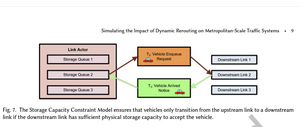February 2, 2023
 Lawrence Berkeley National Laboratory's Cy P Chan, UC Berkeley Civil and Environmental Engineering doctoral student Anu Kuncheria, and Smart Cities Research Center Director Jane Macfarlane recently published Simulating the Impact of Dynamic Rerouting on Metropolitan-Scale Traffic Systems at the Association of Computing Machinery Transactions on Modeling and Computer Simulation: https://doi.org/10.1145/3579842
Lawrence Berkeley National Laboratory's Cy P Chan, UC Berkeley Civil and Environmental Engineering doctoral student Anu Kuncheria, and Smart Cities Research Center Director Jane Macfarlane recently published Simulating the Impact of Dynamic Rerouting on Metropolitan-Scale Traffic Systems at the Association of Computing Machinery Transactions on Modeling and Computer Simulation: https://doi.org/10.1145/3579842Abstract
The rapid introduction of mobile navigation aides that use real-time road network information to suggest alternate routes to drivers is making it more difficult for researchers and government transportation agencies to understand and predict the dynamics of congested transportation systems. Computer simulation is a key capability for these organizations to analyze hypothetical scenarios; however, the complexity of transportation systems makes it challenging for them to simulate very large geographical regions, such as multi-city metropolitan areas. In this paper, we describe enhancements to the Mobiliti parallel traffic simulator to model dynamic rerouting behavior with the addition of vehicle controller actors and vehicle-to-controller reroute requests. The simulator is designed to support distributed-memory parallel execution using discrete event simulation and be scalable on high-performance computing platforms. We demonstrate the potential of the simulator by analyzing the impact of varying the population penetration rate of dynamic rerouting on the San Francisco Bay Area road network. Using high-performance parallel computing, we can simulate a day of the San Francisco Bay Area with 19 million vehicle trips with 50 percent dynamic rerouting penetration over a road network with 0.5 million nodes and 1 million links in less than three minutes. We present a sensitivity study on the dynamic rerouting parameters, discuss the simulator’s parallel scalability, and analyze system-level impacts of changing the dynamic rerouting penetration. Furthermore, we examine the varying effects on different functional classes and geographical regions and present a validation of the simulation results compared to real world data.
